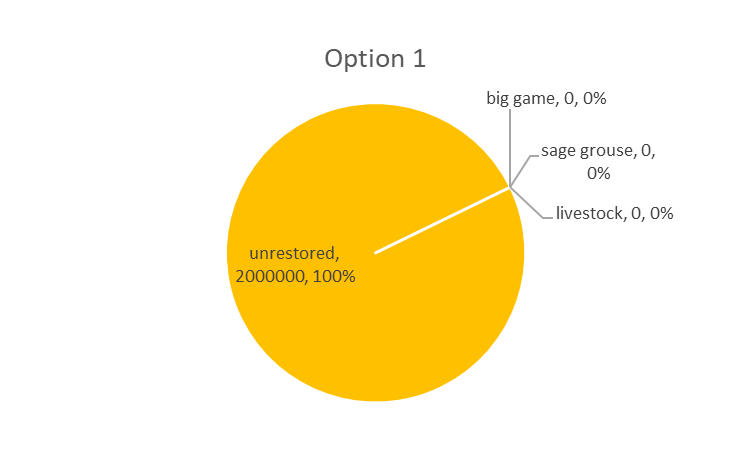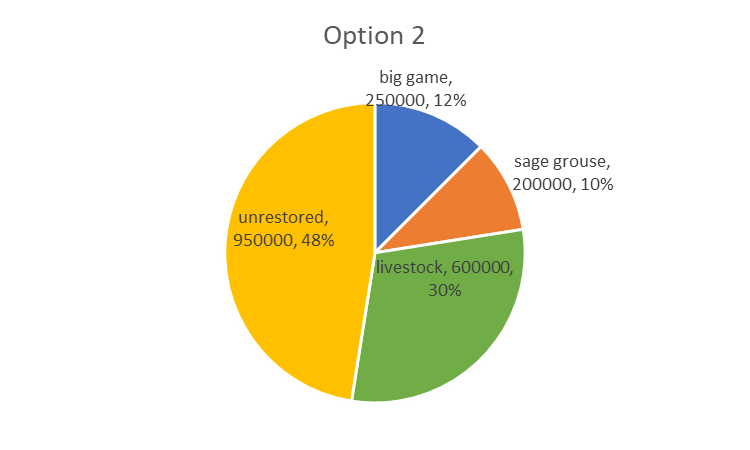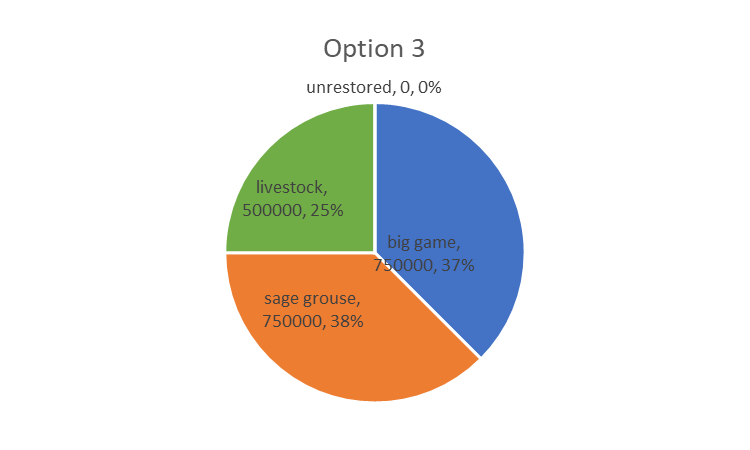Evaluating a questionnaire for future delivery on public values for sagebrush in the West
DOI Generic Clearance for the Collection of Qualitative Feedback on Agency Service Delivery
Questinnaire booklet - sagebrush management 03-05-2019
Evaluating a questionnaire for future delivery on public values for sagebrush in the West
OMB: 1090-0011
OMB No. 1090-0011 Approval Expires:
10/31/2021
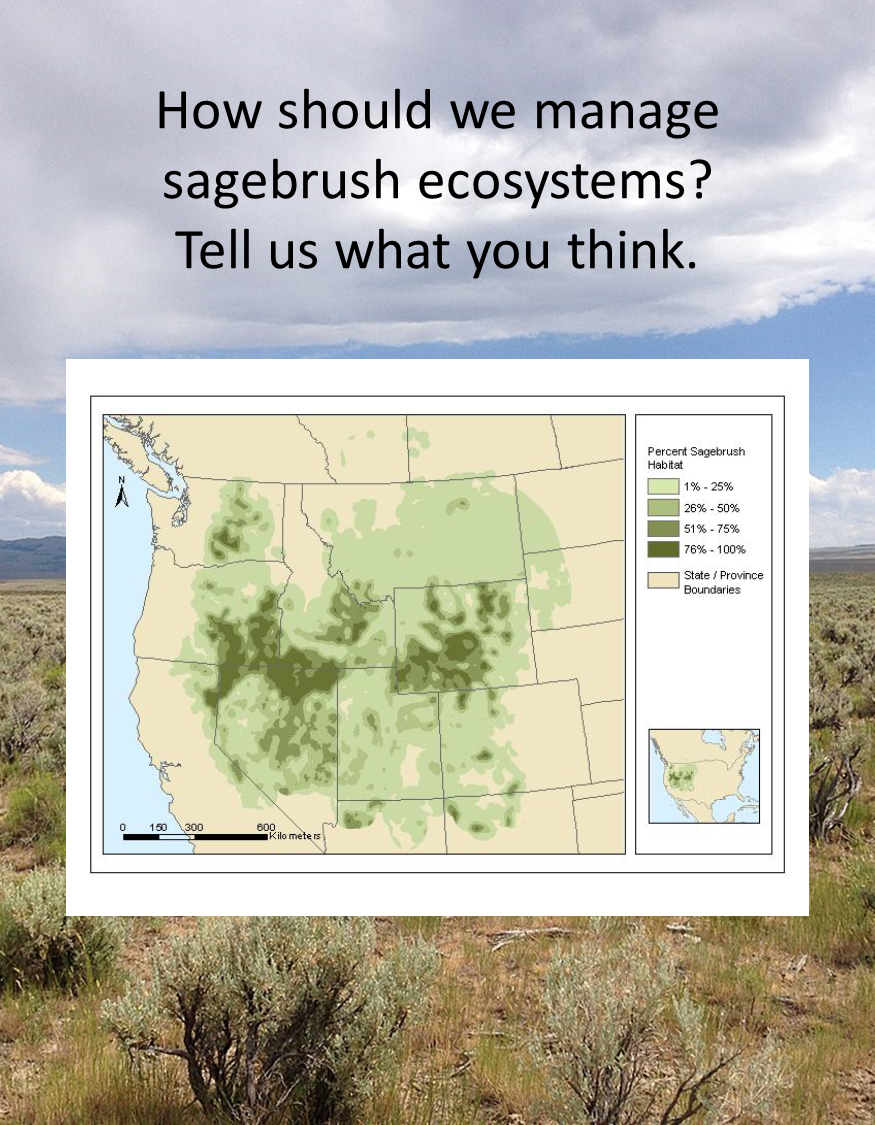
Sagebrush ecosystems
Sagebrush ecosystems, like the one shown on the front of this survey, are communities of plants and animals where several species of sagebrush shrubs are the dominant plants. They also contain many species of grasses, other shrubs, and cactus.
Sagebrush ecosystems cover approximately 72 million acres of public lands, managed for the benefit of all citizens in the western U.S. They provide habitat for hundreds of species of birds and animals, some that are found nowhere else. Important sagebrush species include sage grouse, mule deer, pronghorn, Brewer’s sparrow, and pygmy rabbits. Sage grouse are entirely dependent on sagebrush ecosystems throughout their lifecycle. Pronghorn also depend on sagebrush for most of their lifecycle.

Condition of sagebrush ecosystems
Sagebrush ecosystems are in decline for several reasons, including the spread of non-native plants like cheatgrass and pinyon-juniper woodlands.
Recent decades have seen a general increase in the area burned across the full range of sagebrush ecosystems.
While fire can be a natural part of sagebrush ecosystems, recent wildfires tend to kill most vegetation, and it often takes decades to return to pre-fire conditions.
Without management after a wildfire, sagebrush ecosystems can be taken over by non-native grasses, such as cheatgrass, or experience other changes that can have negative effects on the species that depend on sagebrush.
Many of the non-native plants are not edible for wildlife or livestock.
Some are also especially fire-prone which can result in a cycle of repeated damaging wildfires.
What do sagebrush ecosystems mean to you?
We would like to know more about your experience with sagebrush ecosystems and your preferences for their management. For each of the statements below please indicate how strongly you agree or disagree.
|
Strongly agree |
Agree |
Neither agree nor disagree |
Disagree |
Strongly disagree |
|
|
|
|
|
|
|
|
|
|
|
|
|
|
|
|
|
|
|
|
|
|
|
|
|
|
|
|
|
|
|
|
|
|
|
|
|
|
|
|
|
|
|
|
|
|
|
|
|
|
|
|
|
|
Restoration of sagebrush ecosystems after wildfire
Each year approximately 2 million acres of sagebrush in the western US is burned in wildfires (example in photo A).
If no post-fire restoration occurs, then sagebrush areas become dominated by non-native cheatgrass (example in photo B) which provides little habitat for big game, sage grouse and other wildlife and is poor livestock forage.
I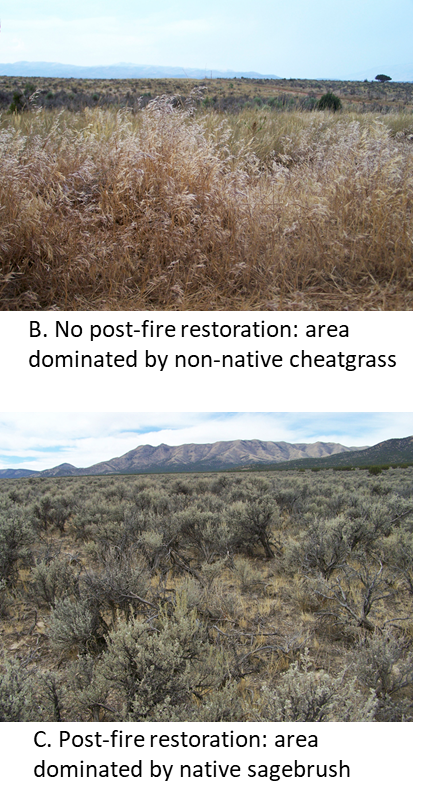 f
post-fire restoration is carried out, sagebrush ecosystems can be
restored to more healthy conditions (example in photo C). This would
result in increased diversity of plants and animals, reduction of
trees that encroach on the open shrublands, reducing or eliminating
non-native, invasive plant species like cheatgrass, increasing native
grasses and flowers, fewer damaging wildfires and less soil erosion.
f
post-fire restoration is carried out, sagebrush ecosystems can be
restored to more healthy conditions (example in photo C). This would
result in increased diversity of plants and animals, reduction of
trees that encroach on the open shrublands, reducing or eliminating
non-native, invasive plant species like cheatgrass, increasing native
grasses and flowers, fewer damaging wildfires and less soil erosion.
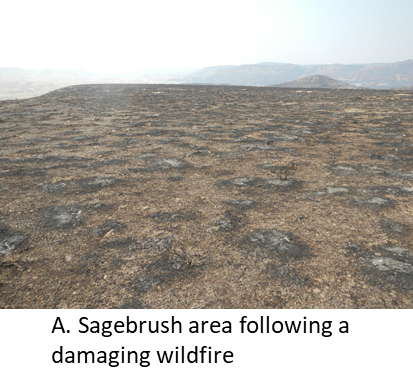
 Possible
restoration actions:
Possible
restoration actions:
Replanting sagebrush after wildfires
Replanting native flowering plants and grasses after wildfires
Controlling invasive species
Reducing the spread of trees into sagebrush areas

Adding fire breaks to reduce the spread of wildfires across the landscape
Possible outcomes of restoration:
Restored landscapes that provide habitat for sage grouse
Increased habitat for big game such as mule deer, pronghorn, and elk
Restoration following fires can be achieved through several management actions, and different actions could lead to different outcomes. The restoration option chosen will also affect how much the plan costs.
The purpose of this survey is to determine your preferences for the different possible options for restoration and the outcomes that would be achieved.
Restoration after fires can create healthy, native plant communities by treating the burned areas to bring back conditions that support livestock, native plant species, native animal and bird species, and reduce soil erosion.
One proposal to fund restoration of sagebrush ecosystems after fires is to set up a special fund dedicated to this restoration effort.
Since 60% of sagebrush ecosystems are on federal land, the dedicated fund would be paid for by an increase in the federal income tax.
The increase would be paid annually and would last for 10 years.
All U.S. households would pay the tax.
On the next page you will be asked to decide whether you would choose to raise taxes to restore sagebrush ecosystems.
Your answers will be used to help the federal government compare the cost of sagebrush restoration with the benefits to American households. The answers you give could affect the amount of sagebrush ecosystems available for livestock and wildlife in the future and the amount of taxes you pay.
In making this decision, please take into account your household income, whether you can afford to make the payment shown, and whether sagebrush restoration programs are worth that much to you.
Consider everything else you could buy with the money and whether there are other government programs that you might rather see money spent on.
Options for sagebrush ecosystem restoration
The table below shows three possible restoration options.
Option 1 does not provide any post-fire restoration and there would be no cost to your household.
Options 2 and 3 are two different post-fire restoration programs that produce different levels of wildlife habitat and/or livestock forage.
The option chosen by a majority of households will be carried out, and all households will pay the amount specified. There is no right or wrong answer, please choose the option that is best for you.
At the bottom of this table, please check the boxes to indicate your most preferred option and your least preferred option:
|
Option 1 No post-fire restoration |
Option 2 Post-fire restoration |
Option 3 Post-fire restoration |
Big game habitat: Acres restored with conditions the specifically support big game such as pronghorn, mule deer and elk. |
0 |
250,000 acres |
750,000 acres |
Sage grouse habitat: Acres restored with conditions that specifically support sage grouse. |
0 |
200,000 acres |
750,000 acres |
Livestock forage: Acres restored with conditions that specifically support livestock such as cattle, sheep, domestic bison. |
0 |
600,000 acres |
500,000 acres |
Acres with no post fire restoration |
2,000,000 |
950,000 acres |
0 |
|
|
|
|
Your household’s annual cost for each of the next 10 years: |
for No post-fire restoration: $0 |
Post-fire restoration Option B: $50 |
Post-fire restoration Option C: $150 |
|
Option 1 |
Option 2 |
Option 3 |
|
Option 1 |
Option 2 |
Option 3 |
|
||||||||||
|
Restoring sagebrush ecosystems is not worth that much to me. |
|||||||||
|
I can’t afford to pay that much. |
|||||||||
|
We need to cut all government spending. |
|||||||||
|
Taxes are too high already. |
|||||||||
|
Sagebrush restoration programs should be paid for with existing tax dollars. |
|||||||||
|
I don’t think that restoration of sagebrush is necessary. |
|||||||||
|
The proposed management (or restoration) program won’t solve the problem of declining sagebrush ecosystems. |
|||||||||
|
Other (please describe): _______________________________________________________________________________________
_______________________________________________________________________________________ |
|||||||||
|
||||||||||
|
Very certain |
|
Certain |
|
Neither certain nor uncertain |
|
Uncertain |
|
Very uncertain |
|
|
||||||||||
|
Very certain |
|
Certain |
|
Neither certain nor uncertain |
|
Uncertain |
|
Very uncertain |
|
Next, we would like to know about you and your recreational activities.
Your answers to these questions will only be used to see how well our survey sample represents the American public as a whole. Your answers are confidential. You will not be identified in any way.
|
||||||||||||||||||||||||||||||||||||||||||||
|
Yes go to question 2 |
|
No go to question 4 |
|||||||||||||||||||||||||||||||||||||||||
|
||||||||||||||||||||||||||||||||||||||||||||
|
Hunting upland game birds |
|
Hunting big game (deer, elk, pronghorn) |
|||||||||||||||||||||||||||||||||||||||||
|
Watching birds or other wildlife |
|
Camping or backpacking |
|||||||||||||||||||||||||||||||||||||||||
|
Hiking or walking |
|
Biking |
|||||||||||||||||||||||||||||||||||||||||
|
Off-highway vehicle use |
|
Scenic driving |
|||||||||||||||||||||||||||||||||||||||||
|
Other outdoor activities (please describe) ______________________________________________________ |
|||||||||||||||||||||||||||||||||||||||||||
|
||||||||||||||||||||||||||||||||||||||||||||
|
1 to 2 times |
|
3 to 5 times |
|
6 to 9 times |
|
10 to 19 times |
|
20 or more times |
|||||||||||||||||||||||||||||||||||
|
||||||||||||||||||||||||||||||||||||||||||||
|
Yes |
|
No |
|||||||||||||||||||||||||||||||||||||||||
|
|
Male |
|
Female |
||||||||||||||||||||||||||||||||||||||||
|
|
18-24 |
|
25-34 |
|
35-44 |
|
45-64 |
|
65 or older |
||||||||||||||||||||||||||||||||||
|
|
Yes |
|
No |
||||||||||||||||||||||||||||||||||||||||
|
||||||||||||||||||||||||||||||||||||||||||||
|
Some high school |
|
High school graduate or equivalent |
|||||||||||||||||||||||||||||||||||||||||
|
Some college or technical school (but no degree) |
|
Associate’s degree (including occupational or academic degrees) |
|||||||||||||||||||||||||||||||||||||||||
|
Bachelor’s degree (BA, BS, AB, etc.) |
|
Master’s degree (MA, MS, MENG, MSW, etc.) |
|||||||||||||||||||||||||||||||||||||||||
|
Doctoral degree (PhD, EdD, etc.) |
|
Professional school degree (MD, DDC, JD, etc.) |
|||||||||||||||||||||||||||||||||||||||||
|
||||||||||||||||||||||||||||||||||||||||||||
|
American Indian or Alaska Native |
|
Native Hawaiian or other Pacific Islander |
|
Asian |
|||||||||||||||||||||||||||||||||||||||
|
Black or African American |
|
White |
|
Other _______________________ |
|||||||||||||||||||||||||||||||||||||||
|
|
Yes |
|
No |
||||||||||||||||||||||||||||||||||||||||
|
||||||||||||||||||||||||||||||||||||||||||||
|
Less than $15,000 |
|
$15,000 up to $24,999 |
|
$25,000 up to $34,999 |
|||||||||||||||||||||||||||||||||||||||
|
$35,000 up to $49,999 |
|
$50,000 up to $74,999 |
|
$75,000 up to $99,999 |
|||||||||||||||||||||||||||||||||||||||
|
$100,000 up to $149,999 |
|
$150,000 up to $199,999 |
|
$200,000 or more |
|||||||||||||||||||||||||||||||||||||||
|
||||||||||||||||||||||||||||||||||||||||||||
|
||||||||||||||||||||||||||||||||||||||||||||
|
||||||||||||||||||||||||||||||||||||||||||||
Thank you taking the time to complete this survey. Use the postage paid return envelope to return the survey.
If you have any additional comments, please use the space below.


Department of Agriculture and Resource Economics
Colorado State University
Fort Collins, CO 80525
Paperwork Reduction Act Statement: We are collecting this information subject to the Paperwork Reduction Act (44 U.S.C. 3501) to assess your preferences for sagebrush restoration at wildfires. Your response is voluntary and results we will not share them publicly. We may not conduct or sponsor, and you are not required to respond to a collection of information, unless it displays a currently valid OMB Control Number. OMB has reviewed and approved this survey and assigned OMB Control Number 1090-0011, which expires 10/31/2021.
Estimated Burden Statement: We estimate this focus group will take you 120 minutes to complete, including time to read instructions, gather information, and complete and submit your responses. You may submit comments on any aspect of this information collection to the Information Collection Clearance Officer, James Sayer, [email protected].
| File Type | application/vnd.openxmlformats-officedocument.wordprocessingml.document |
| File Modified | 0000-00-00 |
| File Created | 0000-00-00 |
© 2025 OMB.report | Privacy Policy
